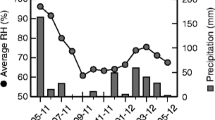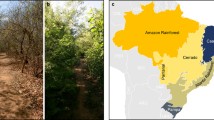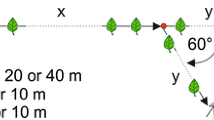Summary
The foraging behavior of three stingless bees,Trigona (Tetragonula) minangkabau, T. (Trigonella) moorei andT. (Heterotrigona) itama, was studied to describe patterns of resource harvest in disturbed forest areas in Sumatra, Indonesia.
-
1.
Average daily total number of foraging flights per colony was 1200 inT. minangkabau, 2400 inT. moorei and 7000 inT. itama and it was proportional to colony population size. Foragers collecting nectar, pollen or plant resin were respectively 70–80%, 10–20% and <10% in the three species. Pollen was collected most in the morning. Nectar collection peaked in midday inT. itama but continued almost evenly until dusk inT. minangkabau andT. moorei. Resin was collected evenly throughout day.
-
2.
In all the three species the volume of a nectar load carried by a returning forager did not decrease until 1600, followed by slight decline. In the morning the sugar concentration of nectar was almost constantly 30%, and in the afternoon its maximum value reached 60% although some remained 30%. As a result, the mean sugar weight in a nectar load gradually increased until dusk.
-
3.
InT. minangkabau, resin was collected by specialized foragers. Nectar foragers switched to collect pollen and vice versa. There were two types of foraging: “exploitatory” flights, the repitition of short, rather constant flights bringing back full resource loads, and “exploratory” flights, prolonged flight and/or reduction in amount of resources carried. Exploitatory flights followed the exploratory flights which led to discovery of rich sources. Mean duration of exploitatory flights was 7 min during nectar collection, 12 min for pollen and 23 min for resin. Sites of exploited flowers were estimated to be 84–434 m distant from the nest site. Mean duration of flights for nectar collection was 13 min in the morning and 6 min in the late afternoon.
Similar content being viewed by others
References
Corbet, S. A. (1978) Bees and the nectar ofEchium vulgare. 21–30. In:A. J. Richards (ed)The pollination of flowers by insects. Springer, Berlin, Heidelberg and New York.
Corbet, S. A., D. M. Unwin andO. E. Prŷs-Jones (1979a) Humidity, nectar and insect visits to flowers, with special reference toCrataegus, Tilia andEchium.Ecol. Entomol. 4: 9–22.
Corbet, S. A., P. G. Willmer, J. W. L. Beament, D. M. Unwin andO. E. Prŷs-Jones (1979b) Postsecretory determinants of sugar concentration in nectar.Plant Cell and Environment 2: 293–308.
Corbet, S. A. andP. G. Willmer (1981) The nectar ofJusticia andColumnea: Composition and concentration in a humid tropical climate.Oecologia 51: 412–418.
Frisch, K. von. (1967)The dance language and orientation of bees. Harvard University Press, Cambridge, Mass.
Heinrich, B. (1976) Resource partitioning among some eusocial insects: Bumblebees.Ecology 57: 874–889.
Heinrich, B. (1979)Bumblebee economics. Harvard University Press, Cambridge, Mass.
Hubbell, S. P. andL. K. Johnson (1977) Competition and nest spacing in a tropical stingless bee community.Ecology 58: 949–963.
Hubbell, S. P. andL. K. Johnson (1978) Comparative foraging behavior of six stingless bee species exploiting a standardized resource.Ecology 59: 1123–1136.
Inoue, T., Sh. F. Sakagami, S. Salmah andS. Yamane (1984) The process of colony multiplication in the Sumatran stingless beeTrigona (Tetragonula) laeviceps (1).Biotropica 16: 100–111.
Johnson, L. K. andS. P. Hubbell (1974) Aggression and competition among sitngless bees: Field studies.Ecology 55: 120–127.
Johnson, L. K. andS. P. Hubbell (1975) Contrasting foraging strategies and coexistence of two bee species on a single resource.Ecology 56: 1398–1406.
Koeniger, N. andG. Vorwohl (1979) Competition for food among four sympatric species of Apini in Sri Lanka.J. Apic. Res. 18: 95–109.
Kerr, W. E. andH. Esch (1965) Comunicação entre as abelhas sociais brasileiras e sua contribução para o entendimento da sua evolução.Ciencia. e. Cult. (São Paulo) 17: 529–538.
Lindauer, M. andW. E. Kerr (1958) Die gegenseitige Verstanding bei den stachellosen Bienen.Zeitschr. vergl. Physiol. 41: 405–434.
Lindauer, M. andW. E. Kerr (1960) Communication between the workers of stingless bees.Bee World 41: 29–41, 65–71.
Maa, T. (1953) An inquiry into the systematics of the tribus Apidini or honeybees (Hym.)Treubia 21: 525–640.
Michener, C. D. (1974)The social behavior of the bees: A comparative study. Belknap Press of Harvard University Press, Cambridge, Mass.
Roubik, D. W. (1978) Competitive interactions between neotropical pollinators and Africanized honey bees.Science 201: 1030–1032.
Roubik, D. W. (1979) Africanized honey bees, stingless bees, and the structure of tropical plant-pollinator communities.Md. Agric. Exp. Sta. Spec. Misc. Publ. 1: 403–417.
Roubik, D. W. (1980) Foraging behavior of competing Africanized honeybees and stingless bees.Ecology 61: 836–845.
Roubik, D. W. (1981) Comparative foraging behavior ofApis mellifera andTrigona corvina (Hymenoptera: Apidae) onBaltimora recta (Compositae).Revista de Biologia Tropical 29: 177–184.
Roubik, D. W. (1982) Ecological impact of Africanized honeybees on native neotropical pollinators. In:P. Jaisson (ed)Social insects in the tropics, vol. 1. Univ. Paris-Nord.
Roubik, D. W. andM. Aluja (1983) Flight ranges of foragingMelipona andTrigona in a tropical forest.J. Kans. Ent. Soc. 56: 217–222.
Roubik, D. W. andS. L. Buchmann (1984) Nectar selection byMelipona andApis mellifera (Hymenoptera: Apidae) and the ecology of nectar intake by bee colonies in a tropical forest.Oecologia 61: 1–10.
Sakagami, Sh. F., T. Matsumura andK. Ito (1982)Apis laboriosa in Himalaya, the little known world largest honeybee (Hymenoptera, Apidae).Insecta Matsumurana New Series 19: 47–77.
Sakagami, Sh. F. (1982) Stingless bees. 361–423. In:H. R. Hermann (ed)Social insects. vol III. Academic Press, New York.
Sakagami, Sh. F., T. Inoue, S. Yamane andS. Salmah (1983) Nest architecture and colony composition of the Sumatran stingless beeTrigona (Tetragonula) laeviceps (1).Kontyû 51: 100–111.
Sakagami, Sh. F. andT. Inoue (1985) Taxonomic notes on three bicolorousTetragonula stingless bees in southeast Asia.Kontyû 53: 174–189.
Visscher, P. K. andT. D. Seeley (1982) Foraging strategy of honeybee colonies in a temperate deciduous forest.Ecology 63: 1790–1801.
Author information
Authors and Affiliations
Additional information
Contribution to the ecological and bioeconomical studies of the stingless bees. 4.
Contribution No. 17 of Sumatra Nature Study (Entomology).
Rights and permissions
About this article
Cite this article
Inoue, T., Salmah, S., Abbas, I. et al. Foraging behavior of individual workers and foraging dynamics of colonies of three Sumatran stingless bees. Res Popul Ecol 27, 373–392 (1985). https://doi.org/10.1007/BF02515474
Issue Date:
DOI: https://doi.org/10.1007/BF02515474




